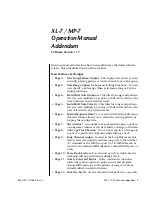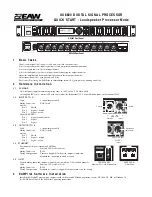
Setting up the unit
To activate the unit, connect the included power supply to the unit and a suitable 230V, 50 Hz power outlet.
The fixture will start up and show the last chosen setting on the display. Usually, with a new product, this is
the DMX mode with the value set on 001.
The display shows several settings, each with the possibility to set several values.
Use the display and the menu buttons to set preferences, change settings and scroll through the menu.
“Enter” is used to save a certain setting or preset, press “Menu” for at least 2 seconds to discard the change
and return to the main menu.
The table below shows an explanation for every feature and value.
display
Mode
Function
ADDR
DMX address setting
A001-A512
SLND
Master/slave mode
Master (default)
Slave 1 - Slave 2
SHND
Auto mode
Auto Speed 1-9
SOUN
Sound controlled mode
Sound controlled mode on/off
SENE
Sound sensitivity
Sound sensitivity 0-100
BLND
Black out mode
YES-NO
DISP
Display inversion
Display Inversion, Idsp-dspI
TEST
Test mode
Self test
Hour
Using time of light
Fixture hours,0 ~ 9999
UERS
Software version
Ver XXX
ADDR:
DMX address setting, used to determine the DMX starting channel. From this channel on, the fixture
will respond to values, corresponding with the amount of channels that the fixture is occupying. (For
example, when set the starting address to value 003, the fixture will respond to channels 3, 4, 5, etc..)
SLND:
When using the master/slave function, you need to connect 2 or more fixtures with XLR-XLR cable.
The first fixture in line needs to be set as master, the others as Slave 1 or 2 (synchronized or mirrored
performance). This way, the slaves will mimic the behavior of the master fixture for wonderful synchronized
lighting shows.
SHND:
Auto mode, with built-in program. Selectable speed (1-9)
SOUN:
Activate or disable the built-in sound controlled mode. This way, the fixture will respond to the beat of
the music.
SENE:
The sensitivity of the built-in microphone is adjustable, to optimize the built-in sound controlled mode.
For example, when your music source (speakers) are placed far away, you might want to increase the
sensitivity to make sure that the fixture responds to the sound accurately.
BLND:
Black out mode (S.L.S.) The Signal Loss Setting provides the right action when the fixture suddenly
loses DMX signal. By activating the function, the fixture goes in blackout mode. By deactivation the mode,
the fixture goes in sound controlled mode.
DISP:
Display invert version – When using the fixture in a hanging setup, it is possible to flip the display, so
the characters will be shown upside down. This makes reading the several statuses much easier.
TEST:
Self test mode, to control all segments and LEDs
Hour:
The fixture shows how much hours it has been active. This is very practical for rental companies
which need to perform service intervals on all fixtures after several hours of performing, to maintain optimal
shape.
UERS:
Displays the software version which is installed on the main PCB.


























